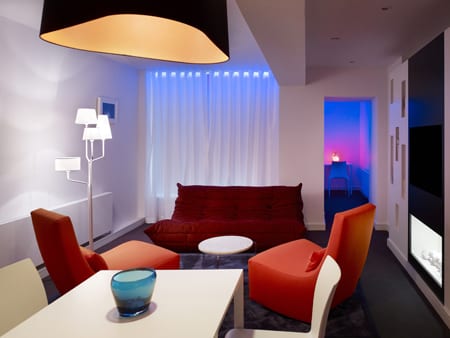By Alia Akkam
In Rome’s colorful Trastevere neighborhood, the popular 80-year-old restaurant Antica Pesa is set in a former customs house, where more than 400 years ago goods were carefully weighed on scales. When Antica Pesa’s owners, the Panella family, decided to bring their concept stateside, to the equally vibrant Brooklyn neighborhood of Williamsburg, local firm BaRC Studio (Brooklyn Architectural Coop) “took the notion of balance as a conceptual driver in designing this project,” says one of BaRC’s principals, Catherine Clark.

  The long and tall space that awaited in Brooklyn-“cavernous and impersonal”-Clark points out, was cozily reimagined by establishing three different zones: the open lounge area by the window, the bar, and the dining room beyond. “The light openness of the front of house is counterbalanced by the kitchen, an area of intense activity. It was important to maintain a relationship between the kitchen and the rest of the space, so a large opening was made to allow visual and physical contact between the two,” Clark explains.Â

Unlike the Rome restaurant, which unfolds in a series of low arches and passageways, a guest can take in the expanse of the Brooklyn eatery at entry. Yet a similar vibe of tranquility has been established through details such as dramatic dome pendant lighting and discreet volumes, including the bar and fireplace wrapped in soft walnut, an elegant contrast to the rough-hewn white painted brick walls.

The theme of old weigh scales is reinforced in the circular acoustic panels above the formal dining room, making for a slightly lower ceiling. Those large pendant lights, “just above head height in the dining area, further create intimacy,” says Clementina Ruggieri, another BaRC principal. “It was an idea inspired by the Blue Mosque in Istanbul, where a floating matrix of fairy lights gently suggests a more human scale in a space which soars above an otherworldly and beautifully ornate ceiling.”

Lighting infuses Antica Pesa with personality throughout, from local artist Doug Newton’s crane-like brass creations flanking the walls in the lounge to his ‘Saturn’-found at both the entry and against a backdrop of Fornasetti wallpaper in the bathroom-which unleashes diffused warm light playing off the repeated form of a circle.

“The food can be categorized as a modern classical take on traditional Roman cuisine. We sought to achieve a modern yet sophisticated space to reflect this,” explains Ruggieri. “Like the Roman restaurant which lures its clientele from across the Tiber, perhaps it will attract a new crowd to Brooklyn from Manhattan, keen to explore another side of the five boroughs.”


